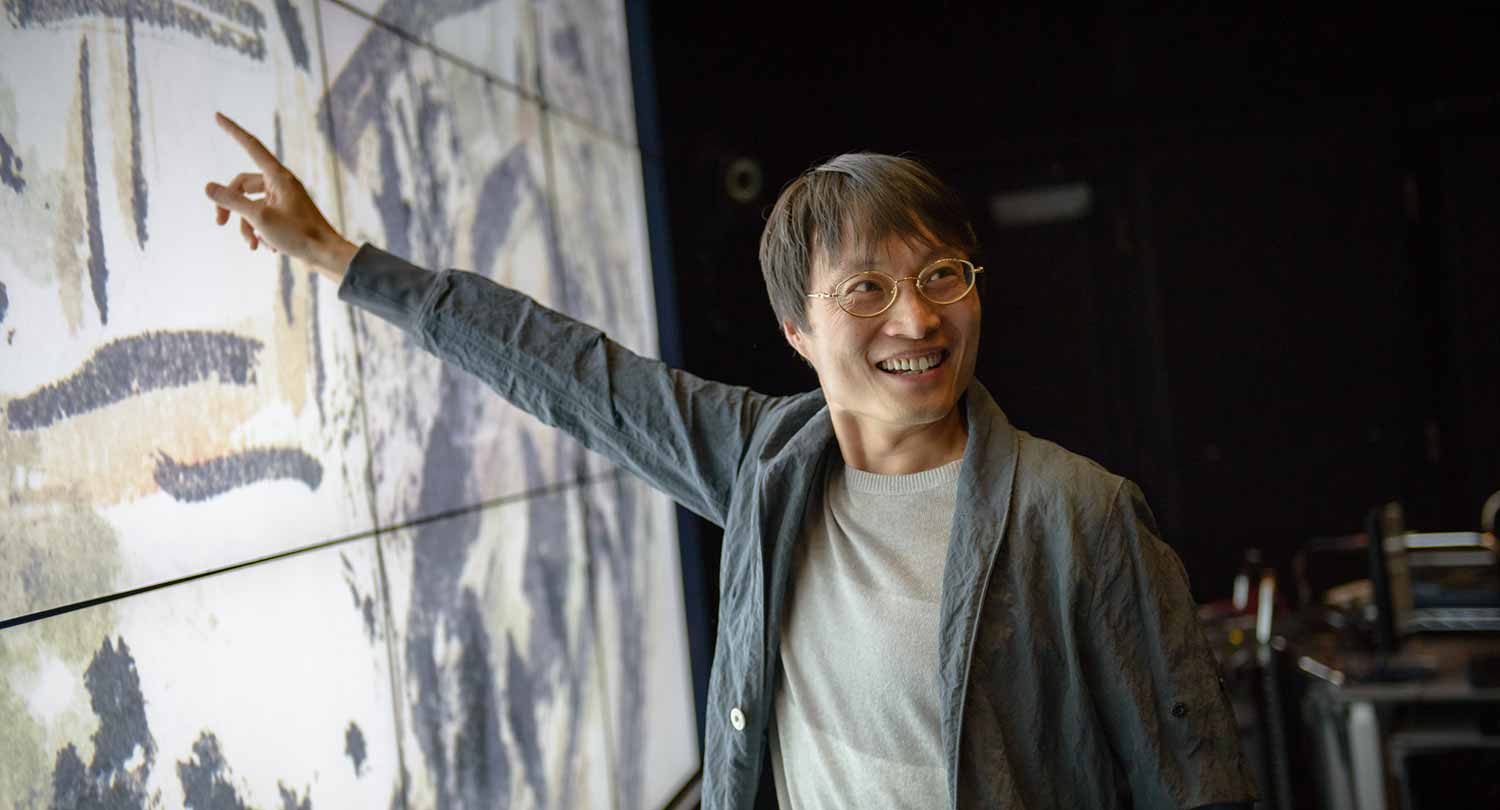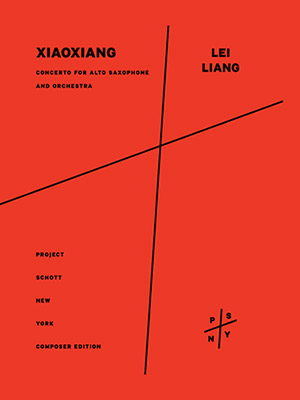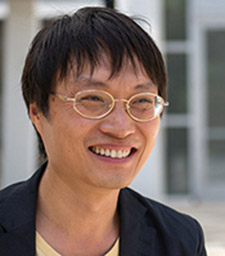
UC San Diego Composer Shortlisted for Pulitzer Prize in Music
Published Date
By:
- Doug Ramsey
Share This:
Article Content

Lei Liang talks about writing music and taking cues from the high-resolution and multi-spectral imagery of Huang Binhong's landscapes. Photo by Alex Matthews/Qualcomm Institute
Xiaoxiang refers to the region in China’s Hunan Province where the rivers Xiao and Xiang intersect. It is also the title of a concerto for alto saxophone and orchestra composed by UC San Diego music professor and Qualcomm Institute composer in residence Lei Liang. The work was one of three finalists for the 2015 Pulitzer Prize for Music. The Pulitzer awards and finalists were announced on Monday, and Xiaoxiang by Lei Liang (published by Schott Music) just missed out on the prize, which went to Julia Wolfe for her folk-classical hybrid, Anthracite Fields, an oratorio about coal miners in Pennsylvania at the turn of the last century.
Lei Liang’s work Xiaoxiang also sets an historical account to music. He wrote the concerto to commemorate a tragic event that took place in the Xiaoxiang region during the Cultural Revolution.
“A woman’s husband was killed by a local official,” says Liang. “Without the means to seek justice, she decided to take revenge on the official by wailing like a ghost in the forest behind the official’s residence every evening. Months later, both the official and the woman went insane.”
Liang used electronically transformed sounds to echo the ghostly wailing, and the concerto “re-synthesizes the electronic sounds through the means of an orchestra,” according to Liang’s liner notes to the published work.
“Inspired by a widow’s wail and blending the curious sensations of grief and exhilaration” is how the Pulitzer Prize committee explained the concerto.

Composer edition of Xiaoxiang, Concerto for Alto Saxophone and Orchestra (Schott Music)
Xiaoxiang had its original premiere at the World Saxophone Congress XV in Bangkok, Thailand, featuring soloist Chien-Kwan Lin backed by the Thailand Philharmonic Orchestra, conducted by Allan McMurray. Xiaoxiang was commissioned by and dedicated to soloist Lin, who also premiered a major revision of the concerto with the Boston Modern Orchestra Project in March 2014, conducted by Gil Rose.
Instead of displaying technical virtuosity, the soloist portrays the protagonist’s inability to articulate or utter. “The soloist’s music is marked by silences,” said Liang. “In that sense, the work may be perceived as an anti-concerto.”
The third finalist in the music category was The Aristos, by John Zorn, a work for violin, cello and piano that creates “a vivid demonstration of the brain in fluid, unpredictable action.”
There is good reason to believe that Lei Liang could have a Pulitzer Prize in his future, at least based on the track record of this year’s winner. Julia Wolfe was previously a runner-up for the prize in 2010 (for her piece, “Steel Hammer”).
If he eventually wins a Pulitzer, Liang would be the third UC San Diego music professor to take home the prize. Former UCSD professor Bernard Rands won the prize in 1984 while on the faculty of the Music department, and Roger Reynolds – the first composer in residence of Calit2’s Qualcomm Institute – received the Pulitzer Prize for Music in 1989 for his work, “Whispers Out of Time.”
Hearing Landscapes
The announcement that he was a finalist for the Pulitzer came just days after Liang premiered some of his new work as “Hearing Landscapes.” A standing-room only crowd in the Calit2 Theater listened and watched a compelling, big-screen journey into 12 Chinese watercolor paintings by Huang Binhong (1865-1955). The music was accompanied by high-resolution images of the landscapes, captured by a team of cultural heritage engineers led by professor Falko Kuester, director of the Center of Interdisciplinary Science for Art, Architecture and Archaeology (CISA3).
The public performance was based on work funded by a 2014 Calit2 Strategic Research Opportunities (CSRO) grant, which funded three days of scanning, multispectral imaging and digitization of the Chinese paintings on loan from Elna Tsao, with the support of the San Francisco-based Mozhai Foundation. The event featured a new piece composed by Lei Liang, and one by Ph.D. student Greg Surges, who also developed audio software for the project (to translate visual cues from the images to the sound environment).

Lei Liang, UC San Diego Professor of Music, and Qualcomm Institute Composer in Residence
As Liang described in his commentary prior to the performance, he is developing new concepts of sonic “shadows” and “lights” to craft a musical language for orchestration and sound spatialization (which made ample use of the 360-degree surround environment in the theater). Liang says that the multispectral imaging of the paintings also provided insights into artist Huang Binhong’s creative process – insights he then used in his composition of the music.
In addition to Liang and Kuester, other researchers involved in the project were invited to share some of their experiences with the audience. They included two key players from professor Peter Otto’s Sonic Arts R&D group: Zachary Seldess (who has since left the institute after being a principal collaborator and top audio software developer on the project), and his successor, audio developer Eric Hamdan. Between them, Seldess and Hamdan drove the project with Liang on both the technical and creative level, providing key tools for sound design and spatialization as well as a composition/playback system for choreographing the movements through the paintings with the music composition in real time.
“This type of system and performance was completely unprecedented at Calit2,” said Hamdan, who also supported Greg Surges’ work by providing the custom joystick software that enabled him to navigate the paintings with a Playstation 3 game controller (which Surges used to control his musical software during the performance of his own piece).
On the visualization end, CISA3 and materials science Ph.D. student Samantha Stout and programmer-analyst Chris McFarland were involved in the capture of the Huang Binhong paintings that were subsequently shown on the floor-to-ceiling Vroom display system. Also on hand: the two robotics engineers – Eric Lo and James Strawson – who custom-built the automated scanning and imaging robot that the team used to speed up the capture of the high-resolution and multi-spectral images.
The multimedia performance in the Calit2 Theater will be reprised on Saturday, May 2, as part of the ArtPower! Filmatic Festival, also in Atkinson Hall.
The next phase of Liang's Huang Binhong project is the large-scale orchestra work, A Thousand Mountains, A Million Streams, which is commissioned by and will be performed by Boston Modern Orchestra Project. The piece will be completed in Liang's third year as composer in residence in Calit2's Qualcomm Institute. His appointment to that position ends June 30, 2016.
Share This:
You May Also Like
Stay in the Know
Keep up with all the latest from UC San Diego. Subscribe to the newsletter today.


